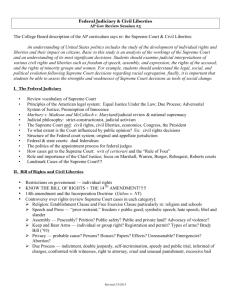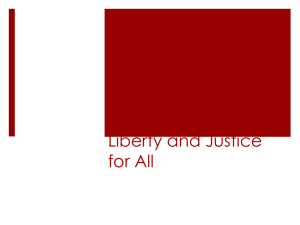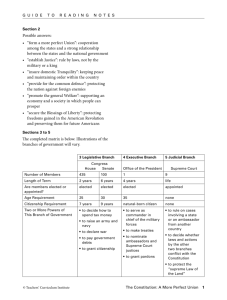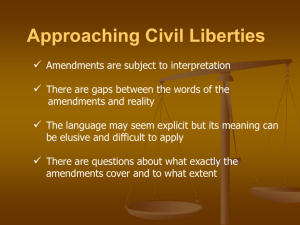2015 AP USGOPO FRQs DeLong Answers
advertisement
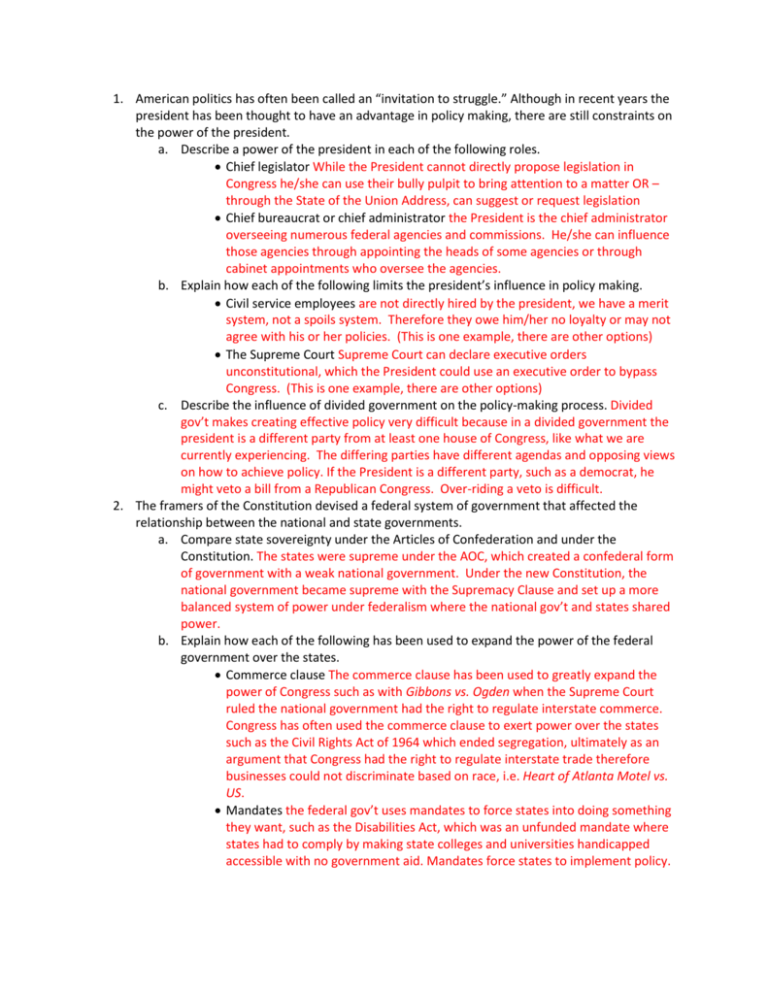
1. American politics has often been called an “invitation to struggle.” Although in recent years the president has been thought to have an advantage in policy making, there are still constraints on the power of the president. a. Describe a power of the president in each of the following roles. Chief legislator While the President cannot directly propose legislation in Congress he/she can use their bully pulpit to bring attention to a matter OR – through the State of the Union Address, can suggest or request legislation Chief bureaucrat or chief administrator the President is the chief administrator overseeing numerous federal agencies and commissions. He/she can influence those agencies through appointing the heads of some agencies or through cabinet appointments who oversee the agencies. b. Explain how each of the following limits the president’s influence in policy making. Civil service employees are not directly hired by the president, we have a merit system, not a spoils system. Therefore they owe him/her no loyalty or may not agree with his or her policies. (This is one example, there are other options) The Supreme Court Supreme Court can declare executive orders unconstitutional, which the President could use an executive order to bypass Congress. (This is one example, there are other options) c. Describe the influence of divided government on the policy-making process. Divided gov’t makes creating effective policy very difficult because in a divided government the president is a different party from at least one house of Congress, like what we are currently experiencing. The differing parties have different agendas and opposing views on how to achieve policy. If the President is a different party, such as a democrat, he might veto a bill from a Republican Congress. Over-riding a veto is difficult. 2. The framers of the Constitution devised a federal system of government that affected the relationship between the national and state governments. a. Compare state sovereignty under the Articles of Confederation and under the Constitution. The states were supreme under the AOC, which created a confederal form of government with a weak national government. Under the new Constitution, the national government became supreme with the Supremacy Clause and set up a more balanced system of power under federalism where the national gov’t and states shared power. b. Explain how each of the following has been used to expand the power of the federal government over the states. Commerce clause The commerce clause has been used to greatly expand the power of Congress such as with Gibbons vs. Ogden when the Supreme Court ruled the national government had the right to regulate interstate commerce. Congress has often used the commerce clause to exert power over the states such as the Civil Rights Act of 1964 which ended segregation, ultimately as an argument that Congress had the right to regulate interstate trade therefore businesses could not discriminate based on race, i.e. Heart of Atlanta Motel vs. US. Mandates the federal gov’t uses mandates to force states into doing something they want, such as the Disabilities Act, which was an unfunded mandate where states had to comply by making state colleges and universities handicapped accessible with no government aid. Mandates force states to implement policy. c. Explain how each of the following has played a role in the devolution of power from the national government to the states. Block grants State have more freedom for monetary distribution with block grants than with categorical grants. Block grants are not as specific giving states more discretion in the spending, versus the federal government mandating how to spend their money. Supreme Court decisions Honestly this is hard to answer because historically the Supreme Court has given more power to the federal government through supporting the Supremacy Clause, elastic clause (necessary and proper clause) and commerce clause, as well as overturning portions of DOMA. Keeping that in mind, I guess I would say the recent court decision overturning the Voting Rights Act saying that it unfairly discriminated against states giving states more freedom in deciding voting requirements such as the increase of states now requiring a photo id. You probably could just say in general how the Supreme Court has the right through judicial review to check the power of Congress and give more power to the states. 3. The framers created the electoral college to elect the president of the United States. This system influences the campaign strategies of presidential candidates. a. Describe one reason that the framers chose to use the electoral college as the method to elect the president. Framers did not trust the average citizen to be educated enough to make the decision, fear of the “tyranny of the majority” b. Describe the message the cartoon above conveys about presidential elections. Emphasis on the power of the swing states, how presidential candidates are focused on winning the states with key numbers of electoral votes c. Explain why California, Texas, and New York do not appear prominently in the cartoon above. Those states consistently have voted for the same parties, NY & CA – Democrat and TX – Republican so one can easily predict how they’ll go though they are important because of their large number of electoral votes. d. Describe two campaign tactics presidential candidates use to win the key states identified in the cartoon above. Not exactly sure what they are looking for here if they’ll accept something as broad as advertising or grassroots or public appearances. It’s a rather broad question. 4. The Fourteenth Amendment protects civil rights and civil liberties. a. Describe the difference between civil rights and civil liberties. Civil liberties are protected by the Bill of Rights, basic rights that everyone has, government should protect. Civil rights are protections against discrimination based on things such as race or gender. b. Identify the primary clause of the Fourteenth Amendment that is used to extend civil rights. The Equal Protection clause c. Describe a specific legislative action that extended civil rights to each of the following. Women 19th Amendment (possibly because made sure you couldn’t be denied the right to vote because you’re a woman) more likely they were looking for the Civil Rights Act of 1964 which covered desegregation and women’s rights (protection against discrimination for hiring, etc.) Persons with disabilities Disabilities Act (Official name is American Disabilities Act) which prevents discrimination based on disabilities like for employment and requires public facilities to be handicapped accessible [this is the one that was an unfunded mandate] d. Identify the primary clause of the Fourteenth Amendment that is used to extend civil liberties. Due process clause (all about selective incorporation guys ) e. Explain how civil liberties were incorporated by the Supreme Court in two of the following cases. Gideon v. Wainwright extended the right to a lawyer(counsel) as guaranteed by the 6th amendment to the states Mapp v. Ohio exclusionary rule, provided protection against illegal search and seizures (illegally gained items cannot be used in court) as guaranteed by the 4th amendment Miranda v. Arizona extended the “rights of the accused” covered in the 5th and 6th amendments to states, requiring police officers to inform citizens of their constitutional rights when they are arrested


